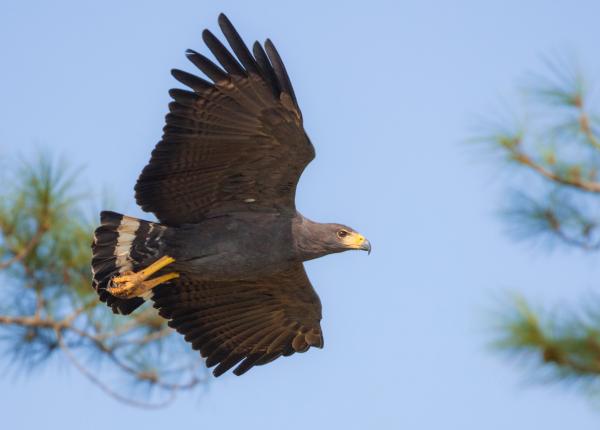How The Peregrine Fund is Helping
The Peregrine Fund doesn't work directly with Wedge-tailed Eagles, but our efforts in scientific research, habitat conservation, education, and community development help conserve raptors around the world. We also supply literature to researchers from our avian research library, which helps scientists around the world gather and share important information on raptor conservation. Through the Neotropical Raptor Network, a listserv that helps researchers throughout the Solitary Eagle's range, we help raptor conservationists learn from each other, collaborate with each other, and share information about raptor conservation.
Where It Lives
This beautiful eagle is a Neotropical species, found from Mexico through Central and South America. It is found primarily in middle and montane elevations in a few different habitats including dry pine forests, humid forests, and cloud forests usually between 600 to 2,200 meters above sea level.
What It Does
The Solitary Eagle is mostly all dark gray. It has longish, yellow legs, dark eyes, a yellow cere, and a black tail marked with white bands. Unlike the Harpy Eagle, this species often soars to great heights, either singly or in pairs. It also spends time perching on the tops of trees, and is rarely found in open spaces.
Why It Needs our Help
The Solitary Eagle is categorized as Near Threatened. It is considered a rare species and scientists know very little about the biology, behavior or breeding of this species. Loss of habitat and shooting are some of the greatest threats this species faces.
What It Eats
There is still a lot that we need to learn about the Solitary Eagle's diet. From the information that does exist, we know they feed on snakes, and that snakes might make up the majority of their diet. However, they will also take other animals such as lizards, medium-sized birds (such as Chachalacas) and small mammals.
Nests, Eggs, and Young
Just as there is a lot we need to learn about this species' diet, we also don't know very much about this eagle's breeding habitats. In general, we know they build large cup-shaped structures made of coarse sticks which they line with finer sticks and fresh green leaves, including palm fronds.
The female will lay one egg. Once the eaglet hatches, both parents will work hard to take care of it. We don't know how long the incubation period lasts, or how long the young eaglet stays in the nest. Researchers in Belize observed the juvenile in its parents' territory for several months after fledgling.
Solitary Eagle and the World Center for Birds of Prey
The World Center for Birds of Prey offers fun ways to learn about raptors of all kinds. Interactive activities, tours, interesting videos and a children's room with activities from coloring sheets and quizzes to costumes and a touch table are available for the curious mind. We also have several different birds of prey on display year-round, including several eagle species! Though we don't have any resident Solitary Eagles at the World Center for Birds of Prey, if you visit you will be rewarded with an opportunity to meet Fancy, our resident Ornate Hawk-eagle, and Grayson a Harpy Eagle. At the visitor center, you will see these amazing birds of prey, and others, up close in our outdoor aviary. Our knowledgeable staff is on hand to answer any questions you may have.
References:
Bierregaard, R. O., D. A. Christie, G. M. Kirwan, and C. J. Sharpe (2020). Solitary Eagle (Buteogallus solitarius), version 1.0. In Birds of the World (J. del Hoyo, A. Elliott, J. Sargatal, D. A. Christie, and E. de Juana, Editors). Cornell Lab of Ornithology, Ithaca, NY, USA. https://doi.org/10.2173/bow.soleag1.01









